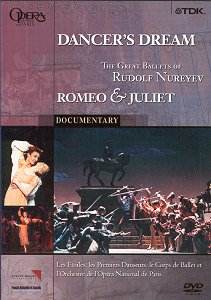This
documentary film is about one third talking heads (live colour
video), one third ballet rehearsal (live colour video), with the
rest snippets from live staged performances (colour film) and
background images and historical footage (B/W). All the heads
talk in French, and even when an interview is in English, there
is a French voice-over. Sound and picture quality are excellent
especially considering that in most scenes original SECAM video
is converted to PAL for the disk and then to NTSC for my television.
As a result of this, in one brief scene of a very detailed black
and white engraving of the facade of a cathedral the screen was
covered in a checkerboard of scintillating rainbow colours—well,
it was kind of pretty.
The
scenario is that in 1995 the Paris Opera ballet is mounting a
revision of the Nureyev choreography of Romeo and Juliet,
and the ballet tutors, Patricia Ruanne and Frederic Jahn, both
of whom had danced with Nureyev in London and Paris, talk at great
length about how the changes they are making are fully in the
spirit of Nureyev and that their revered teacher would wholeheartedly
approve of their production. There is some historical footage
of previous productions, including a 1955 Bolshoi production from
Russian newsreels. Curiously, they say that the Russian productions
are not well documented: were they unaware of the 1955 Soviet
colour film of virtually the whole ballet?
It
is pointed out that Nureyev worked with Martha Graham in the USA
before he began choreographing Romeo and Juliet. He then
had a special interpreter go over Shapespeare’s play for him word
by word to be sure he understood every word of the play perfectly.
In particular, the characters of Mercutio and Tybalt were greatly
strengthened and the crowd fight scenes were brought to frightening,
dangerous realism. The energy of the dancing was brought to the
fatigue point for the dancers: "Rudolf wanted a step for
every note." "He thought like a film director, and in
the crowd scenes wanted something going on in every corner of
the stage." After working themselves to the point of collapse,
the best the dancers could hope to obtain from Nureyev at the
end of an exhausting day of rehearsals was, "See, you can
do it!" Oddly, Romeo is shown to be a passive character with
everyone else making decisions for him. While at first the English
critics decried this as an error, eventually it was seen to be
just what Shakespeare portrayed.
The
Italian stage designer Ezio Frigerio mentioned that Nureyev wanted
a realistic Italian Renaissance quality to the settings. "He
had strong ideas of what he wanted from looking at Renaissance
paintings, but I had to keep reminding him that I grew up with
the Renaissance all around me every day." Also, "Death
is always present in this work, and we had images of death before
us in every scene."
The
best part of the film is the rehearsals, watching these beautiful
young healthy dancers working their way through the actions one
at a time, with the tutor, then alone, then in ensemble, then
together with props, than in costume on the stage, sometimes cutting
from one to the other on a single beat. If ever you thought it
was easy to be a ballet dancer, this film will knock that idea
right out of you. And it also disposes forever of the image of
the effeminate male dancer. These guys are as tough as they come,
and in the fight scenes with swords and knives tremendous skill
and care were required to prevent serious injury. What I question
is whether this degree of violence was actually a realistic reflection
of Shakespeare’s experience of Elizabethan London (as Nureyev
claimed), or more likely the usual English tendency to portray
almost every other people as more violent and irrational. I remember
one critic commenting on what he thought was the excessive musical
violence and passion in Tchaikovsky’s Romeo and Juliet:
"Yes, they were Italians, but not Persians!"
A
most amazing revelation is that in this production the final tomb
scene was never rehearsed, it was left to the dancers to improvise
it, so it was different every time.
This
film is not a good way to become acquainted with the ballet. It
is assumed that the viewer is already familiar with the story,
the music, and the dancing, preferably from one of the Nureyev
choreographed versions. If you’re working on your French accent,
this film could help you with that, as it presents you with 89
minutes of varied examples of Parisian French, English accented
French, and Italian accented French.
Paul
Shoemaker
